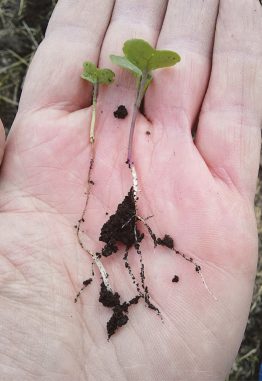Use seed treatment to minimize early disease
Key practice: A registered seed treatment with multiple fungicide active ingredients can minimize the threat of seed and seedling diseases. Seeding early, shallow and with good seed to soil contact for quick emergence also helps prevent early disease infection. Start field scouting 10 to 14 days after seeding.
Key research: Hwang, S.F., Alberta Agriculture and Rural Development (AARD). “The Effect
of Seed Size, Seed Treatment, Seeding Date and Depth on Rhizoctonia Seedling Blight of Canola.” Canadian Journal of Plant Science (2014).
Hwang, S.F., AARD. “Reducing Seedling Blight to Improve Stand Establishment in Hybrid Canola.”
Canola Agronomic Research Program (CARP) project (2007-1).
Canola is vulnerable to a number of seed and seedling diseases. A registered seed treatment with multiple fungicide active ingredients can minimize this threat. While early seeding is best for yield in general, shallow seeding and good seed to soil contact allow the crop to establish as quickly as possible, making it less susceptible to disease. It’s also important to start field scouting 10 to 14 days after seeding, looking for diseased seed as well as dying or dead plants.
Canola seeded too deep is at higher risk of seedling diseases. Deep seeding requires a long hypocotyl for the plant to reach the soil surface, which exposes more of the plant to soil-borne disease pathogens. Deep seeding also extends the days to emergence, which means the plant is at its vulnerable stage for longer.
Sheau-Fang Hwang of AARD in Edmonton has led a number of studies on reducing seedling blight in canola. These studies examined the efficacy of fungicide seed treatments on suppressing various diseases in canola, and evaluated the effects of factors such as seeding date, seeding depth, seed size and soil temperatures.
Hwang’s 2014 paper “The Effect of Seed Size, Seed Treatment, Seeding Date and Depth on Rhizoctonia Seedling Blight of Canola,” summarizes greenhouse and field experiments on canola inoculated with R. solani, the most commonly isolated pathogen associated with the canola seedling blight complex.
Two seed treatments commonly used against the seedling blight complex were applied to canola for seeding in both the greenhouse and field-plot studies. Both treatments were applied at the labeled rate and each consisted of both a broad-spectrum fungicide and an insecticide.
Under greenhouse conditions, inoculations with R. solani reduced seedling emergence, plant height and shoot weight by an average of 35 percent compared with the non-inoculated control. In the field trials, inoculation reduced plant emergence by 88 to 91 percent and seed yield by 62 to 84 percent compared with the control.
Over three of the trial years, inoculation with R. solani reduced seedling emergence by an average of 95 percent with corresponding yield reductions averaging 87 percent in comparison with the non-inoculated control. Throughout this study, seed yield was greater for the early and mid-seeding dates and seed treatment consistently improved both seedling emergence and seed yield under high inoculum pressure.

Although early seeding generally improved seedling emergence in inoculated trials, seed size and seeding depth had very little effect on emergence and yield in this study. However, Hwang concludes that fungicidal seed treatments can play an important role in stabilizing canola stand establishment under heavy disease pressure by R. solani.




